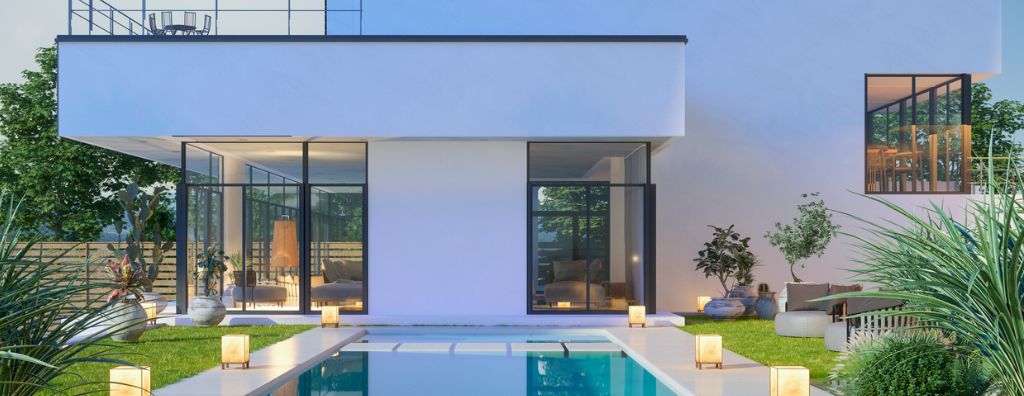Discover the current Patterns in Modern Home Design for Your Following Task
Developments in clever home innovation are improving just how we connect with our living areas. As we check out these aspects, it becomes evident that the future of home design is not simply regarding looks, but additionally regarding developing adaptable settings that improve our day-to-day lives.
Open Floor Program
Open floor strategies are significantly prominent in modern home style, as they foster a sense of spaciousness and connectivity amongst living areas - melbourne home residential projects. This architectural fad eliminates traditional barriers, such as wall surfaces and doors, that usually separate kitchen areas, eating spaces, and living areas. By incorporating these areas, home owners can delight in a more natural setting that encourages communication and versatility
Among the main advantages of open layout is their capacity to boost all-natural light throughout the home. With less walls blocking light flow, spaces really feel brighter and more welcoming, developing a joyful environment. In addition, this format permits much easier motion and socialization, making it ideal for families and entertaining visitors.
Furthermore, open layout can provide better layout convenience, enabling homeowners to curate their rooms with a more unified visual. The smooth shift between locations enables innovative design options and furniture plans that can adapt to various needs.
While open layout have numerous advantages, it is necessary to consider prospective challenges, such as noise control and personal privacy. When attentively created, open floor plans continue to be a characteristic of contemporary home design, reflecting contemporary lifestyles.
Lasting Products
Over the last few years, the use of sustainable products in home design has actually gained significant focus as homeowners seek to lower their environmental impact. This pattern mirrors a growing recognition of the ecological impacts of conventional structure materials and a desire for greener options.
Sustainable materials encompass a broad variety of alternatives, consisting of redeemed timber, recycled steel, bamboo, and low-VOC (volatile natural compounds) paints. Recovered timber, as an example, not just decreases deforestation however likewise adds personality to a home with its special history. Bamboo, known for its quick development, presents a green option that is both durable and cosmetically pleasing.
Incorporating lasting products into home design also improves energy performance. Insulation made from recycled materials, for instance, can dramatically lower energy intake for heating & cooling, causing lower utility bills. Additionally, numerous lasting products are sourced in your area, more lowering the carbon impact related to transport.
As the demand for ecologically responsible building grows, designers and builders are significantly focusing on sustainable materials. This shift not only benefits the environment yet additionally develops healthier living rooms for home owners, straightening contemporary navigate to this website architecture with a sustainable future.
Smart Home Innovation
The integration of clever home innovation has arised as a famous trend in modern-day style, enhancing making use of lasting materials. melbourne home residential projects. This technical development improves the performance and efficiency of residential spaces, giving homeowners with unprecedented control over their living settings
Smart home systems enable users to manage lighting, climate, security, and entertainment with centralized applications or voice commands. These features not only boost comfort however additionally promote power preservation by optimizing source use. Smart thermostats can discover individual choices and readjust home heating or cooling down accordingly, significantly reducing energy intake.
Additionally, advancements in home automation help with boosted security through clever locks, electronic cameras, and alarm systems, which can be kept an eye on from another location. This assimilation boosts satisfaction for home owners while supplying included convenience.
Incorporating wise modern technology into home style likewise influences building aesthetic appeals. Designers are currently producing spaces that seamlessly integrate modern technology, making sure that gadgets are both practical and aesthetically appealing. As a result, modern-day homes symbolize a harmonious equilibrium in between innovative modern technology and thoughtful style, making clever home technology a key factor to consider for any future building project.
Biophilic Style
How can architecture enhance our link to nature? Biophilic style functions as a compelling solution to this question, integrating natural components into built environments to promote a much deeper bond between Go Here residents and the bordering ecosystem. This layout approach focuses on making use of organic materials, all-natural light, and plant life, producing areas that promote wellness and enhance the high quality of life.
Incorporating attributes such as large home windows, living walls, and interior gardens can significantly boost air top quality and provide a feeling of tranquility. The tactical positioning of these components view website permits unblocked sights of nature, getting rid of the obstacles in between indoor and outdoor rooms. Additionally, using all-natural materials like wood, rock, and water not just mirrors the setting yet also stimulates a sensory experience that resonates with human impulses.
Biophilic design also stresses the relevance of biodiversity, motivating the use of native plants and lasting landscape design methods. By welcoming this technique, designers can produce homes that not just value the environment yet likewise boost the psychological and psychological health of their inhabitants. Taking on biophilic principles in modern-day style is an important action towards a much more harmonious conjunction with nature.
Flexible Rooms

Key components of versatile rooms consist of movable dividings, modular furnishings, and innovative storage options that improve usability. These attributes enable citizens to personalize their environments according to their preferences, fostering a sense of ownership and personalization. Furthermore, integrating technology, such as smart home systems, can better facilitate this adaptability by allowing users to regulate lighting, environment, and multimedia experiences with simplicity.

Conclusion
Including the newest trends in contemporary home architecture can significantly boost the living experience. The assimilation of smart home innovation improves performance and protection, and biophilic design develops an important link to nature.